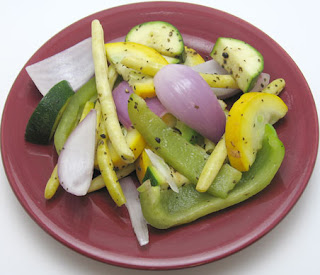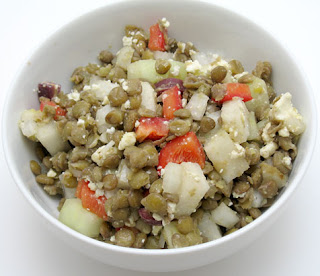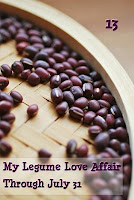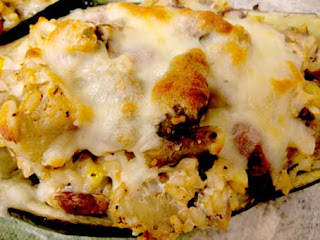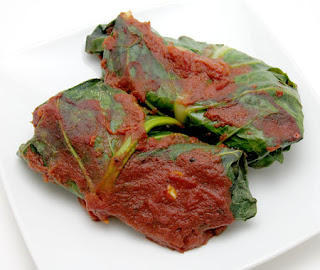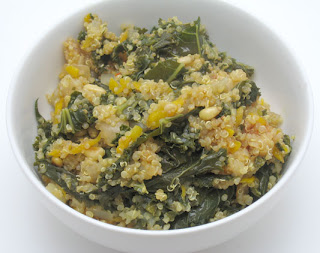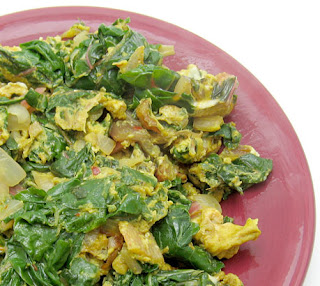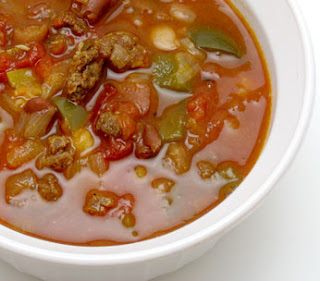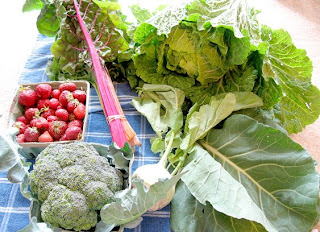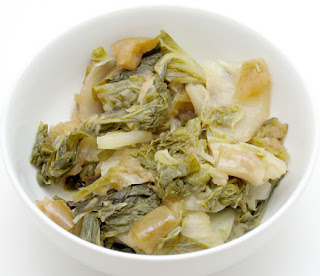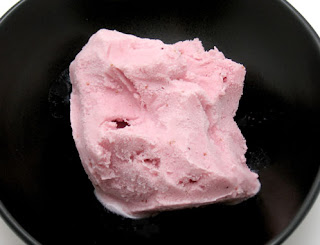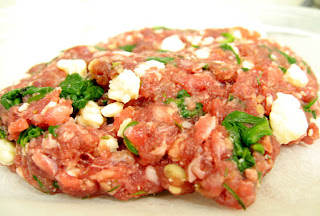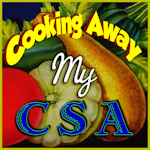
Ok, folks... it's storytime. I considered not saying anything until I had made a firm decision about this, but it's affecting me and what I've been cooking, so it's time to share.
I had reached a point where I had grown accustomed to feeling "off" - not horrible, just not great - fairly often. Given that I eat a fairly healthy diet and get tons of exercise, it didn't make a whole lot of sense. But this alone didn't make me worry because I thought it was just me (I'm kinda weird in general, so maybe my body was just playing along). It didn't really stop me from doing anything, so I figured it would be ok.
Then a couple of weeks ago I noticed that I was developing conditioned taste aversions to some foods. I would have one or two servings of something and it would be one of my favorite dishes. Then the thought of eating it again would repulse me and I would have to force it down until it was gone (the thought of throwing away food makes me cringe). Was I somehow becoming an anti-leftovers person? Not really - it seemed to only happen with certain foods, and the ones that I noticed in particular were
spelt berry salad,
homemade ravioli, and
date and oat bars. Hmmm... wheat seemed to be a common denominator. And then came the horrible stomach cramps. Twice last week I developed horrible cramps (like someone was stabbing me in the stomach, sides, and back) a little while after eating. And both times I happened to be eating a fair amount of wheat. That was the final straw.
While I was still doubled over in pain from the second episode of pain, I decided to stop eating wheat and all glutenous products. The idea of having problems with gluten (the main protein in wheat, barley, and rye) wasn't foreign to me. I have a good friend who has been on a gluten-free diet for the four years that I've known her, and I've also learned more about gluten issues recently through several gluten-free recipe blogs that I follow because they have great recipes. In fact, just last week I noticed Alta from
Tasty Eats at Home wrote about a very similar realization and conversion to a gluten-free lifestyle. I suppose that's why I came to the conclusion so quickly, although not quickly enough. I have no idea whether I have celiac disease (an autoimmune disorder in which gluten triggers inflammation of the small intestine), a wheat allergy/sensitivity, or neither (although this would involve some weird coincidences). My basic plan is to go a month without gluten and then try to eat wheat and see what happens. And don't worry, I also plan to talk to my doctor and a nutritionist about it after the month is over. It's already been 9 days, and I feel a whole lot better. I have a lot more energy, I'm running faster, and I haven't had any weird stomach cramps.
What has gluten, you might ask. Well, lots of things. Anything with wheat, barley, or rye, and almost all oats (due to cross-contamination during processing). This means the obvious (flour, bread, wheat or barley cereals, wheat berries, etc.), as well as beer, most soy sauce, anything with barley malt extract (which is used as a sweetener in a wide variety of things), anything using gluten as a binder (including a TON of packaged foods), and some preservatives and artificial flavorings/colorings. In terms of eating at home, it's really not a big deal. I already try to avoid all additives, so that's not a problem. I also minimize the added sweetener that I consume (and didn't have anything with barley malt extract in my pantry or refrigerator), so no loss there. I'll have to say goodbye to several of my favorite grains (at least temporarily), but I can deal with that if it makes me feel better. I still have millet, quinoa, certified gluten-free oats, corn, teff, and brown rice to get me through. After raiding my entire kitchen, the pile of off-limits stuff was fairly small, and consists mostly of wheat/spelt/Kamut berries, shredded wheat cereal, puffed Kamut, pasta, crackers, bread, protein bars, and several sauces (soy, worcestershire, and oyster). Through some miracle, everything else is gluten-free.
The real challenge is eating out. It's harder to make sure that there's no gluten in any of the ingredients, and many waiters/waitresses don't understand what needs to be done to completely avoid gluten. Unfortunately I decided to start this at the beginning of a conference, when I didn't have time to do research or prepare foods. I rarely eat out under normal circumstances, but due to extremely long days, it was a necessity. I originally planned to pack most meals that weren't provided, but all of my plans involved gluten in some way (like making a sandwich out of the bread in my freezer or carrying leftover pasta). I had no time to prepare something to eat for the week, and it was somewhat scary. The first day I had a meeting over lunch, and ended up eating a ton of salad (with no dressing, as many have gluten) and a pile of chicken and cheese. It was an odd meal for someone like me who doesn't eat much meat, but I had no other options. After ordering 20 pizzas that night for a workshop that I organized, I sat in the corner sipping water. The next day I had to go to lunch on my own because I couldn't think of any gluten-free options at the restaurant that my friends chose. And it didn't get any better the following day when I left the conference for the afternoon to attend a wedding. My only options for dinner at the reception were a small plate of salad (again sans dressing) and a plate full of broccoli and melon slices. Now, if anyone can handle a plate of broccoli it's probably me, but it's not exactly a filling meal. I had to watch my wine consumption because I was afraid that drinking on a virtually empty stomach would cause me to embarrass myself far more than I was willing to accept. It was also hard to pass up a lot of free beer at the conference, especially considering that I just developed a real appreciation for beer. Even though it was tough, I'm very glad that the conference happened to be in East Lansing this year, because I was able to eat breakfast at home and bring along a few snacks to get me through the day.
It was a scary few days, but now that life has returned to normal, it's not such a big deal anymore. The only real downside is that if this is a permanent thing, I'll end up spending a lot more money on ingredients (gluten-free flours are extraordinarily expensive, and require other enhancers). For now I'm going to hold off and do without bread for the month (so far corn tortillas and brown rice cakes seem to be getting me through). I also have a few options for eating out, now that I've had time to do research. Many of the chains are coming out with gluten-free menus (but I try to avoid chains, so I don't know how much I'll take advantage of that). There's also a
pizza joint nearby that makes gluten-free pizzas and subs. They're ridiculously expensive because all of the flours cost so much, but it could be an occasional treat. The thought of going on a trip is frightening, but I'll learn to plan ahead and pack tons of food.
The good news? I can still eat my favorite foods. If someone told me I had to stop eating fruits or vegetables, I would cry for days. But this I can deal with. And who knows, perhaps this isn't really the problem and I'll be able to eat normally after this month. I would rather prepare for the worst and be pleasantly surprised if this isn't permanent.
So how might this affect the blog? Well, it might only affect things for the next month. If not, it will mean more recipes featuring gluten-free grains and grain substitutions (you might notice that
I used brown rice pasta the other day, which is very tasty and already had a home in my pantry). If it's permanent, I'll eventually learn how to bake with other grains and I'll share those recipes. I'll also have to tweak my Whole Grains 101 series, but nothing will change for now. In all honesty, I don't think it will have a dramatic impact on the blog as a whole. Looking back over the past few months, very few recipes involved wheat or barley, and I've never liked rye. As I told Mom, as long as they don't start sprinkling flour over the produce at the farmers' market or in my CSA share, everything will be fine. As I've gone through this transition, though, I've been craving comfort foods like crazy. I think it's my attempt to prove to myself that I can still make all of my favorite foods. So there may not be as much experimentation going on in the next month or so, but we all need a return to the classics from time to time, right?
I'm discovering that there's a huge gluten-free community that exists in the blogging world, and it's really nice to have lots of resources to get me through this. It will be extremely helpful to have fellow bloggers who are also going through this transition right now (like Alta), in addition to ones who have been living gluten-free for years and have great advice and perfected recipes. So, as Karina from
Karina's Kitchen - Recipes from a Gluten Free Goddess pointed out the other day, it's time to celebrate independence from gluten. I will be doing that today with some
gluten-free beer (made from sorghum) and great friends.
 Life is full of odd coincidences. I made this lasagna last week, and was planning to post about it today. When I woke up this morning, I learned that it is National Lasagna Day. I'm not sure whether I should be excited or creeped out, but nevertheless, here's a great lasagna to celebrate the "holiday."
Life is full of odd coincidences. I made this lasagna last week, and was planning to post about it today. When I woke up this morning, I learned that it is National Lasagna Day. I'm not sure whether I should be excited or creeped out, but nevertheless, here's a great lasagna to celebrate the "holiday." 








